
|
It brightened up to 6.8 mag in September (Sept. 17, Seiichi Yoshida). Now it is 8.3 mag (Oct. 3, Paul Camilleri). It will be fading gradually after this. It is observable in excellent condition in the Southern Hemisphere. It will be getting lower gradually in the Northern Hemisphere.
Date(TT) R.A. (2000) Decl. Delta r Elong. m1 Best Time(A, h)
Oct. 6 7 1.05 -6 13.3 0.484 1.078 85 7.7 4:34 (328, 44)
Oct. 13 7 11.49 -13 42.1 0.529 1.115 88 8.1 4:40 (339, 39)
|

|
Now it is 11.2 mag (Oct. 3, Paul Camilleri). It will brighten up to 9 mag until winter. In the Northern Hemisphere, it stays observable in good condition for a long time until it fades out. In the Southern Hemispehre, it is observable in good condition until autumn, but it will be low in winter.
Date(TT) R.A. (2000) Decl. Delta r Elong. m1 Best Time(A, h)
Oct. 6 6 8.19 12 50.6 1.149 1.652 100 10.3 4:34 (337, 66)
Oct. 13 6 25.32 14 11.7 1.084 1.630 102 10.0 4:40 (346, 69)
|

|
It brightened up to 7.7 mag in June (June 19, Juan Jose Gonzalez). Now it is fading. But it is still bright as 10.2 mag (Oct. 1, Chris Wyatt). It stays bright as 9-10 mag for a while. In the Southern Hemisphere, it stays observable in good condition for a long time until the comet will fade out. In the Northern Hemisphere, it is not observable for a long time until autumn in 2019 when the comet fades out down to 16 mag.
Date(TT) R.A. (2000) Decl. Delta r Elong. m1 Best Time(A, h)
Oct. 6 14 29.34 -62 42.2 2.621 2.305 60 10.0 19:01 ( 31,-28)
Oct. 13 14 33.57 -64 0.7 2.693 2.329 58 10.2 18:52 ( 30,-29)
|

|
Now it is bright as 10.9 mag (Oct. 1, Chris Wyatt). It will approach to Earth down to 0.08 a.u. in December, and it is expected to brighten up to 3 mag. In the Northern Hemisphere, it stays observable in excellent condition. In the Southern Hemisphere, it is observable in good condition until mid December when it brightens up to 3 mag. But it becomes unobservable after that.
Date(TT) R.A. (2000) Decl. Delta r Elong. m1 Best Time(A, h)
Oct. 6 1 55.61 -27 41.1 0.440 1.378 143 10.8 0:59 ( 0, 27)
Oct. 13 1 57.34 -29 38.9 0.390 1.325 141 10.1 0:33 ( 0, 26)
|

|
Outburst occured on Aug. 14. Now it is very bright as 11.4 mag (Oct. 3, Paul Camilleri). It is observable in excellent condition in the Northern Hemisphere. It stays low in the Southern Hemisphere.
Date(TT) R.A. (2000) Decl. Delta r Elong. m1 Best Time(A, h)
Oct. 6 0 29.99 32 53.4 0.475 1.436 151 11.9 23:30 ( 0, 88)
Oct. 13 0 32.67 34 34.8 0.459 1.418 151 11.9 23:05 ( 0, 90)
|

|
Now it is 12.1 mag (Sept. 5, Thomas Lehmann). It will be fading slowly after this. In the Northern Hemisphere, it stays low until October. But it will be observable in good condition after that. In the Southern Hemisphere, it is not observable until summer in 2019.
Date(TT) R.A. (2000) Decl. Delta r Elong. m1 Best Time(A, h)
Oct. 6 12 36.06 46 36.8 3.557 3.038 51 12.0 4:34 (223, 15)
Oct. 13 12 53.54 45 44.1 3.563 3.076 53 12.1 4:40 (226, 17)
|

|
Now it is 12.5 mag (Sept. 21, Paul Camilleri). It stays 12 mag for a long time until spring.
Date(TT) R.A. (2000) Decl. Delta r Elong. m1 Best Time(A, h)
Oct. 6 9 1.05 10 23.1 3.195 2.797 57 12.3 4:34 (284, 36)
Oct. 13 9 0.72 8 19.0 3.102 2.820 64 12.3 4:40 (293, 42)
|
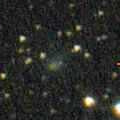
|
It brightened rapidly in outburst up to 6.9 mag (July 19, Maik Meyer). Then it faded down to 9.3 mag (Aug. 2, Katsumi Yoshimoto). It approached to Sun down to 0.2 a.u. in August, and it was expected to brighten up to 3 mag. However, it must have been already disintegrated. In the Northern Hemisphere, it will appear in the morning sky soon. But it will be too faint to observe.
Date(TT) R.A. (2000) Decl. Delta r Elong. m1 Best Time(A, h)
Oct. 6 12 21.04 16 15.4 2.209 1.336 22 13.0 4:34 (250, -1)
Oct. 13 12 33.37 17 31.5 2.289 1.469 26 13.5 4:40 (252, 4)
|
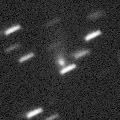
|
It brightened up to 8.7 mag in July (July 18, Marco Goiato). Now it is fading. But it is still bright as 12.3 mag (Aug. 29, Chris Wyatt). It will be unobservable soon even in the Southern Hemisphere. In the Northern Hemisphere, it is not observable until late December.
Date(TT) R.A. (2000) Decl. Delta r Elong. m1 Best Time(A, h)
Oct. 6 13 44.27 -27 58.6 2.432 1.605 26 13.0 19:01 ( 68,-19)
Oct. 13 14 1.58 -27 17.3 2.572 1.699 23 13.4 18:52 ( 69,-18)
|

|
Outburst occured on Sept. 20. Now it is bright as 11.6 mag (Oct. 1, Paul Camilleri).
Date(TT) R.A. (2000) Decl. Delta r Elong. m1 Best Time(A, h)
Oct. 6 22 50.66 -0 13.0 4.878 5.771 150 13.2 21:50 ( 0, 55)
Oct. 13 22 48.49 -0 26.7 4.938 5.771 143 13.2 21:21 ( 0, 55)
|

|
It brightens up to 13 mag in October. But it is not observable at all.
Date(TT) R.A. (2000) Decl. Delta r Elong. m1 Best Time(A, h)
Oct. 6 13 37.26 -8 37.4 2.032 1.084 13 13.8 19:01 ( 86, -9)
Oct. 13 14 6.49 -9 38.9 2.035 1.092 13 13.2 18:52 ( 83, -8)
|

|
Now it is bright as 12.6 mag (Oct. 3, Paul Camilleri). It stays at 12-13 mag from summer to autumn. It is observable in excellent condition in the Southern Hemisphere. It locates somewhat low in the Northern Hemisphere.
Date(TT) R.A. (2000) Decl. Delta r Elong. m1 Best Time(A, h)
Oct. 6 22 29.10 -28 24.7 1.233 2.051 133 13.4 21:29 ( 0, 27)
Oct. 13 22 31.41 -27 51.4 1.297 2.063 127 13.6 21:04 ( 0, 27)
|
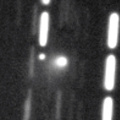
|
Now it is 13.9 mag (Sept. 3, Paul Camilleri). It stays at 14-15 mag for a long time from summer to winter. It will be unobservable soon in the Southern Hemisphere. In the Northern Hemisphere, it stays observable for a long time until it fades out. But it stays extremely low.
Date(TT) R.A. (2000) Decl. Delta r Elong. m1 Best Time(A, h)
Oct. 6 15 30.65 -3 14.0 2.502 1.868 41 13.7 19:01 ( 74, 16)
Oct. 13 15 43.21 -1 55.3 2.511 1.834 38 13.6 18:52 ( 76, 16)
|
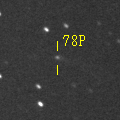
|
Now it is 13.5 mag (Sept. 29, Piotr Guzik). It stays at 12-13 mag for a long time from winter to autumn in 2019. It stays observable in good condition until winter when the comet brightens up to 12-13 mag.
Date(TT) R.A. (2000) Decl. Delta r Elong. m1 Best Time(A, h)
Oct. 6 21 19.68 -8 12.9 1.724 2.459 126 13.9 20:20 ( 0, 47)
Oct. 13 21 20.75 -8 35.9 1.768 2.430 120 13.8 19:54 ( 0, 46)
|

|
It approached to Earth down to 0.3 a.u., and brightened up to 8.3 mag in July (July 22, Juan Jose Gonzalez). Now it is fading. But it is still bright as 12.9 mag (Sept. 8, Chris Wyatt). It will be unobservable soon.
Date(TT) R.A. (2000) Decl. Delta r Elong. m1 Best Time(A, h)
Oct. 6 15 8.24 -6 57.1 2.326 1.620 35 13.9 19:01 ( 74, 10)
Oct. 13 15 9.82 -6 39.7 2.477 1.680 29 14.2 18:52 ( 77, 6)
|
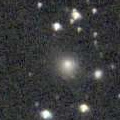
|
Now it is 14.0 mag (Sept. 6, Paul Camilleri). It stays 13-14 mag until summer in 2019. It will be unobservable soon in the Southern Hemisphere, or in November in the Northeren Hemisphere.
Date(TT) R.A. (2000) Decl. Delta r Elong. m1 Best Time(A, h)
Oct. 6 16 21.01 9 10.7 3.865 3.400 55 14.3 19:01 ( 76, 34)
Oct. 13 16 23.31 7 5.7 3.934 3.381 50 14.3 18:52 ( 77, 29)
|

|
Now it is 14.3 mag (Aug. 17, Ken-ichi Kadota). It will be observable at 13-14 mag for a long time from 2017 to 2018. In the Southern Hemisphere, it will be hardly observable after this. In the Northern Hemispehre, it became low temporarily in September, but it will become high after this.
Date(TT) R.A. (2000) Decl. Delta r Elong. m1 Best Time(A, h)
Oct. 6 11 56.70 35 5.5 4.934 4.239 41 14.4 4:34 (237, 15)
Oct. 13 11 58.24 34 49.3 4.904 4.268 45 14.4 4:40 (241, 20)
|

|
Now it is 14.2 mag (Sept. 17, Seiichi Yoshida). It will brighten up to 14 mag in winter. It will be observable in excellent condition in the Northern Hemisphere. In the Southern Hemisphere, it is not observable until summer in 2019.
Date(TT) R.A. (2000) Decl. Delta r Elong. m1 Best Time(A, h)
Oct. 6 6 36.12 60 48.5 1.591 1.958 95 14.6 4:34 (197, 62)
Oct. 13 7 3.50 63 53.4 1.550 1.952 97 14.5 4:40 (193, 60)
|

|
Now it is 13.8 mag (Oct. 3, Paul Camilleri). It will brighten up to 12 mag in autumn in 2019. It stays observable in good condition for a while in the Southern Hemisphere. In the Northern Hemisphere, it stays extremely low for a long time.
Date(TT) R.A. (2000) Decl. Delta r Elong. m1 Best Time(A, h)
Oct. 6 2 36.02 -47 8.6 4.248 4.860 122 15.0 1:39 ( 0, 8)
Oct. 13 2 26.66 -47 13.8 4.201 4.814 122 14.9 1:03 ( 0, 8)
|

|
Now it is 14.5 mag (Aug. 16, P. Camilleri, H. Williams). It stays 15 mag from 2018 to 2019, and it will be observable for a long time in the Southern Hemisphere. In the Northern Hemisphere, it will never be observable again.
Date(TT) R.A. (2000) Decl. Delta r Elong. m1 Best Time(A, h)
Oct. 6 14 36.13 -67 1.5 4.377 4.056 64 15.0 19:01 ( 26,-28)
Oct. 13 14 57.06 -67 28.6 4.404 4.041 62 15.0 18:52 ( 25,-28)
|

|
Now it is 18.4 mag (Sept. 17, iTelescope Observatory, Siding Spring). It locates low. But it brightens up to 14.5 mag from October to November.
Date(TT) R.A. (2000) Decl. Delta r Elong. m1 Best Time(A, h)
Oct. 6 15 20.48 -18 26.4 1.438 0.932 40 16.1 19:01 ( 63, 5)
Oct. 13 15 49.06 -20 43.2 1.374 0.889 40 15.5 18:52 ( 60, 5)
|

|
Now it is 17.3 mag (Sept. 14, A. Diepvens). It will brighten up to 13-14 mag in winter, and it will be observable in excellent condition. It locates low in the Southern Hemisphere.
Date(TT) R.A. (2000) Decl. Delta r Elong. m1 Best Time(A, h)
Oct. 6 8 56.14 29 41.5 2.569 2.328 64 16.2 4:34 (262, 47)
Oct. 13 9 10.83 29 21.8 2.477 2.308 68 16.0 4:40 (265, 51)
|
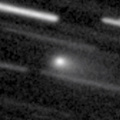
|
It brightened up to 12 mag from spring to summer. Now it is fading. But it is bright as 14.1 mag still now (Sept. 7, Thomas Lehmann).
Date(TT) R.A. (2000) Decl. Delta r Elong. m1 Best Time(A, h)
Oct. 6 22 57.51 5 25.5 1.226 2.165 153 16.0 21:57 ( 0, 61)
Oct. 13 22 55.50 5 8.6 1.305 2.205 146 16.4 21:28 ( 0, 60)
|

|
It brightened up to 7.1 mag from May to June in 2017 (June 21, Juan Jose Gonzalez). Now it is fading. It has already faded down to 16.6 mag (Sept. 3, Slooh.com Chile Observatory, La Dehesa). In the Southern Hemisphere, it stays observable for a long time after this. It will never be observable again in the Northern Hemisphere.
Date(TT) R.A. (2000) Decl. Delta r Elong. m1 Best Time(A, h)
Oct. 6 1 31.56 -54 50.5 5.014 5.575 119 16.2 0:35 ( 0, 0)
Oct. 13 1 24.80 -54 47.0 5.104 5.636 117 16.3 0:01 ( 0, 0)
|
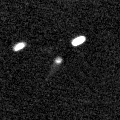
|
It will brighten up to 15 mag in winter. It is observable in excellent condition in the Northern Hemisphere. It is not observable at all in the Southern Hemisphere.
Date(TT) R.A. (2000) Decl. Delta r Elong. m1 Best Time(A, h)
Oct. 6 11 4.51 38 43.6 3.970 3.407 49 16.3 4:34 (239, 26)
Oct. 13 11 8.03 39 45.5 3.858 3.390 55 16.2 4:40 (241, 31)
|
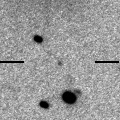
|
Now it is 16.7 mag (Sept. 19, ATLAS-MLO, Mauna Loa). It is expected to brighten up to 7-8 mag in 2020. In 2018, it will be observable at 15-16 mag in good condition from autum to winter.
Date(TT) R.A. (2000) Decl. Delta r Elong. m1 Best Time(A, h)
Oct. 6 3 57.11 -5 14.3 5.694 6.397 131 16.3 3:00 ( 0, 50)
Oct. 13 3 54.39 -5 27.8 5.569 6.338 137 16.2 2:30 ( 0, 50)
|

|
Now it is 16.2 mag (Sept. 16, Mt. Lemmon Survey). It is observable in good condition in the Southern Hemisphere. It locates somewhat low in the Northern Hemisphere.
Date(TT) R.A. (2000) Decl. Delta r Elong. m1 Best Time(A, h)
Oct. 6 22 51.75 -20 9.7 2.515 3.363 142 16.3 21:51 ( 0, 35)
Oct. 13 22 49.21 -20 0.1 2.593 3.378 135 16.4 21:21 ( 0, 35)
|
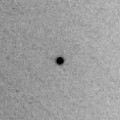
|
Now it is 16.2 mag (June 17, Jean-Francois Soulier). It stays 16 mag for a while. In the Northern Hemisphere, it stays observable in good condition after this until it fades out. It is not observable in the Southern Hemisphere. Its cometary activity was observed on Mar. 26 (M. Mommert, D. Polishook, N. Moskovitz).
Date(TT) R.A. (2000) Decl. Delta r Elong. m1 Best Time(A, h)
Oct. 6 2 24.76 53 14.5 1.417 2.176 127 16.5 1:29 (180, 72)
Oct. 13 2 9.98 54 11.0 1.441 2.235 131 16.5 0:47 (180, 71)
|
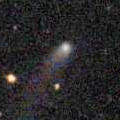
|
It brightened up to 14.7 mag in early 2018 (Jan. 25, Catalina Sky Survey). Now it is fading slowly. Now it is 16.5 mag (Sept. 16, Kunihiro Shima). In the Northern Hemisphere, it stays observable in good condition for a long time until the comet fades out. It is never observable again in the Southern Hemisphere.
Date(TT) R.A. (2000) Decl. Delta r Elong. m1 Best Time(A, h)
Oct. 6 8 24.01 56 34.0 5.893 5.820 80 16.5 4:34 (220, 54)
Oct. 13 8 24.94 57 50.6 5.810 5.841 86 16.5 4:40 (215, 57)
|

|
Now it is 16.9 mag (Sept. 12, D. Buczynski). It stays 16-17 mag for a long time until 2020. It is observable in good condition in the Northern Hemisphere. It is not observable at all in the Southern Hemisphere.
Date(TT) R.A. (2000) Decl. Delta r Elong. m1 Best Time(A, h)
Oct. 6 10 38.49 67 23.8 8.679 8.488 75 16.8 4:34 (208, 37)
Oct. 13 10 47.98 67 29.0 8.613 8.484 79 16.8 4:40 (208, 39)
|
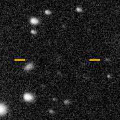
|
Now it is 17.1 mag (Sept. 16, Ken-ichi Kadota). It is observable at 16.5 mag in good condition from autumn to winter. It locates somewhat low in the Southern Hemisphere.
Date(TT) R.A. (2000) Decl. Delta r Elong. m1 Best Time(A, h)
Oct. 6 7 40.42 28 22.6 2.314 2.363 80 16.9 4:34 (275, 62)
Oct. 13 7 51.28 27 54.3 2.238 2.367 84 16.9 4:40 (280, 66)
|
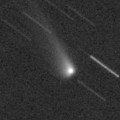
|
Now it is 16.4 mag (Sept. 18, ATLAS-MLO, Mauna Loa). Fading now. It stays observable in good condition for a long time after this in the Southern Hemisphere. It stays low in the Northern Hemisphere.
Date(TT) R.A. (2000) Decl. Delta r Elong. m1 Best Time(A, h)
Oct. 6 23 23.47 -37 44.4 4.158 4.898 133 16.9 22:23 ( 0, 17)
Oct. 13 23 14.10 -38 31.6 4.267 4.925 126 17.0 21:46 ( 0, 17)
|

|
Asteroid, but it brightened rapidly. Now it is 16.8 mag (Aug. 16, Slooh.com Chile Observatory, La Dehesa).
Date(TT) R.A. (2000) Decl. Delta r Elong. m1 Best Time(A, h)
Oct. 6 22 55.73 -46 19.1 6.217 6.816 123 17.0 21:55 ( 0, 9)
Oct. 13 22 47.50 -46 13.8 6.284 6.801 117 17.0 21:19 ( 0, 9)
|

|
First return of a new periodic comet which brightened up to 16.5 mag in 2005. Now it is 17.3 mag (Sept. 15, A. Martin, K. Kleemann-Boeker). It will be observable at 17 mag in good condition in autumn. It locates low in the Southern Hemisphere.
Date(TT) R.A. (2000) Decl. Delta r Elong. m1 Best Time(A, h)
Oct. 6 1 58.40 35 25.2 1.177 2.078 145 17.0 1:02 (180, 89)
Oct. 13 1 56.87 34 47.2 1.157 2.086 150 17.0 0:33 ( 0, 90)
|

|
Now it is 17.3 mag (Sept. 18, Catalina Sky Survey). It will brighten very rapidly after this. It will brighten up to 14.5 mag from January to February, and it is expected to be observable in excellent condition.
Date(TT) R.A. (2000) Decl. Delta r Elong. m1 Best Time(A, h)
Oct. 6 8 8.61 20 12.1 1.765 1.747 72 17.3 4:34 (283, 52)
Oct. 13 8 27.09 18 57.5 1.690 1.724 74 17.1 4:40 (288, 55)
|

|
First return of a new periodic comet which brightened up to 17.5 mag in 2010. Now it is 18.1 mag (Sept. 9, Mt. Lemmon Survey). It is expected to brighten up to 16.5 mag from November to December. It is observable in excellent condition in the Northern Hemisphere. It locates low in the Southern Hemisphere.
Date(TT) R.A. (2000) Decl. Delta r Elong. m1 Best Time(A, h)
Oct. 6 5 40.52 25 37.3 1.420 1.959 106 17.2 4:34 (347, 80)
Oct. 13 5 49.99 26 34.6 1.357 1.957 111 17.1 4:25 ( 0, 82)
|

|
Now it is 16.5 mag (Sept. 17, J. Nicolas, C. Rinner, F. Kugel, A. Klotz). It will be fading after this. It will be fainter than 18 mag in December.
Date(TT) R.A. (2000) Decl. Delta r Elong. m1 Best Time(A, h)
Oct. 6 21 24.18 -7 29.9 1.256 2.032 128 17.1 20:25 ( 0, 48)
Oct. 13 21 27.98 -7 38.9 1.295 2.013 122 17.2 20:01 ( 0, 47)
|

|
Now it is 18.0 mag (Sept. 10, iTelescope Observatory, Mayhill). It is observable at 17 mag in good condition in winter. It locates low in the Southern Hemisphere.
Date(TT) R.A. (2000) Decl. Delta r Elong. m1 Best Time(A, h)
Oct. 6 9 31.29 21 14.2 2.484 2.067 54 17.3 4:34 (268, 36)
Oct. 13 9 45.05 20 54.2 2.452 2.103 58 17.2 4:40 (271, 40)
|

|
Now it is 19.7 mag (Sept. 18, R. Fichtl). It will brighten rapidly. It is expected to be observable at 15.5 mag in good condition in winter.
Date(TT) R.A. (2000) Decl. Delta r Elong. m1 Best Time(A, h)
Oct. 6 4 51.15 -7 2.0 1.313 1.985 117 17.5 3:54 ( 0, 48)
Oct. 13 4 55.94 -7 22.9 1.237 1.959 122 17.3 3:31 ( 0, 48)
|

|
Now it is 16.8 mag (Sept. 14, A. Diepvens). It will be fading gradually after this, and it will be fainter than 18 mag in winter. In the Northern Hemisphere, it stays observable in good condition for a long time. In the Southern Hemisphere, it will never be observable again.
Date(TT) R.A. (2000) Decl. Delta r Elong. m1 Best Time(A, h)
Oct. 6 22 44.75 76 16.2 7.339 7.687 106 17.3 21:44 (180, 49)
Oct. 13 22 40.71 75 36.9 7.333 7.713 108 17.3 21:12 (180, 49)
|
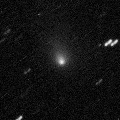
|
It brightened very rapidly up to 13.8 mag in last August (Aug. 22, 2017, Kunihiro Shima). Now it is 16.8 mag (Aug. 18, Slooh.com Canary Islands Observatory). In the Northern Hemisphere, it stays observable in excellent condition after this. It will be observable also in the Southern Hemisphere in December, but it stays low.
Date(TT) R.A. (2000) Decl. Delta r Elong. m1 Best Time(A, h)
Oct. 6 9 31.48 28 47.6 2.785 2.402 57 17.3 4:34 (259, 39)
Oct. 13 9 44.79 28 45.2 2.736 2.426 61 17.4 4:40 (262, 43)
|

|
It was observed at 17 mag in last winter. It will be observable in good condition at 17.5 mag also in this winter.
Date(TT) R.A. (2000) Decl. Delta r Elong. m1 Best Time(A, h)
Oct. 6 5 43.53 9 33.9 7.652 7.987 106 17.5 4:34 (353, 64)
Oct. 13 5 40.65 9 6.6 7.542 7.993 113 17.4 4:16 ( 0, 64)
|
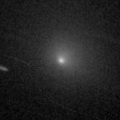
|
It brightened rapidly, and brightened up to 10.2 mag from May to June (May 22, Chris Wyatt). Now it is fading. It has already faded down to 16.9 mag (Sept. 16, ATLAS-HKO, Haleakala). It stays observable in good condition for a long time after this. But it will be fainter than 18 mag in October.
Date(TT) R.A. (2000) Decl. Delta r Elong. m1 Best Time(A, h)
Oct. 6 0 13.39 -9 32.0 1.189 2.167 163 17.5 23:12 ( 0, 46)
Oct. 13 0 6.07 -8 35.1 1.276 2.229 157 18.0 22:38 ( 0, 47)
|

|
Return of a new periodic comet which brightened up to 17 mag in 2001. It was missed at the last return in 2010. Now it is 19.1 mag (Sept. 8, E. Schwab, D. Abreu). It was predicted to brighten up to 17.5 mag from September to November. But actually, it is a bit fainter than predicted.
Date(TT) R.A. (2000) Decl. Delta r Elong. m1 Best Time(A, h)
Oct. 6 1 58.15 -13 41.6 1.247 2.191 154 17.5 1:02 ( 0, 41)
Oct. 13 1 52.77 -13 22.3 1.240 2.192 156 17.5 0:29 ( 0, 42)
|

|
It brightened very rapidly. Now it is 17.3 mag (Sept. 16, Mt. Lemmon Survey). It will be fading after October.
Date(TT) R.A. (2000) Decl. Delta r Elong. m1 Best Time(A, h)
Oct. 6 23 58.30 -18 0.8 0.802 1.757 154 17.5 22:58 ( 0, 37)
Oct. 13 23 55.07 -17 4.1 0.825 1.757 148 17.6 22:27 ( 0, 38)
|
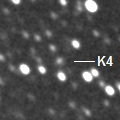
|
Now it is 16.8 mag (Sept. 11, D. Buczynski). It was observed at 16 mag from summer to autumn in 2017. It will be observable at 17 mag in good condition also in 2018. It locates somewhat low in the Southern Hemisphere.
Date(TT) R.A. (2000) Decl. Delta r Elong. m1 Best Time(A, h)
Oct. 6 0 51.18 29 45.6 2.796 3.727 155 17.5 23:50 ( 0, 85)
Oct. 13 0 46.90 29 23.0 2.831 3.772 157 17.6 23:19 ( 0, 84)
|

|
Now it is 17.6 mag (Sept. 13, iTelescope Observatory, Mayhill). It was observed at 18 mag in last winter. It will be observable in good condition at 17.5 mag also in this winter.
Date(TT) R.A. (2000) Decl. Delta r Elong. m1 Best Time(A, h)
Oct. 6 7 5.87 9 38.4 2.747 2.855 85 17.8 4:34 (314, 57)
Oct. 13 7 12.06 8 49.3 2.669 2.866 91 17.7 4:40 (325, 60)
|

|
Now it is 17.8 mag (Aug. 23, iTelescope Observatory, Siding Spring). It stays 17 mag in 2018.
Date(TT) R.A. (2000) Decl. Delta r Elong. m1 Best Time(A, h)
Oct. 6 5 14.12 3 12.8 7.232 7.679 113 17.8 4:17 ( 0, 58)
Oct. 13 5 13.73 2 54.8 7.172 7.713 119 17.8 3:49 ( 0, 58)
|

|
It brightened rapidly up to 11.1 mag (July 13, Chris Wyatt). Now it is fading. It has already faded down to 16.4 mag (Sept. 16, Kunihiro Shima). It will be fainter than 18 mag in October.
Date(TT) R.A. (2000) Decl. Delta r Elong. m1 Best Time(A, h)
Oct. 6 23 55.15 -21 46.8 0.732 1.677 150 17.8 22:54 ( 0, 33)
Oct. 13 23 47.83 -19 44.4 0.830 1.748 145 18.3 22:20 ( 0, 36)
|
|
![]()
 C/2016 M1 ( PanSTARRS )
C/2016 M1 ( PanSTARRS ) 46P/Wirtanen
46P/Wirtanen 64P/Swift-Gehrels
64P/Swift-Gehrels C/2016 R2 ( PanSTARRS )
C/2016 R2 ( PanSTARRS ) C/2016 N6 ( PanSTARRS )
C/2016 N6 ( PanSTARRS ) C/2017 S3 ( PanSTARRS )
C/2017 S3 ( PanSTARRS ) C/2017 T3 ( ATLAS )
C/2017 T3 ( ATLAS ) 29P/Schwassmann-Wachmann 1
29P/Schwassmann-Wachmann 1 26P/Grigg-Skjellerup
26P/Grigg-Skjellerup 48P/Johnson
48P/Johnson C/2018 L2 ( ATLAS )
C/2018 L2 ( ATLAS ) 78P/Gehrels 2
78P/Gehrels 2 C/2018 N1 ( NEOWISE )
C/2018 N1 ( NEOWISE ) C/2017 M4 ( ATLAS )
C/2017 M4 ( ATLAS ) C/2015 O1 ( PanSTARRS )
C/2015 O1 ( PanSTARRS ) (944) Hidalgo
(944) Hidalgo C/2018 N2 ( ASASSN )
C/2018 N2 ( ASASSN ) C/2017 B3 ( LINEAR )
C/2017 B3 ( LINEAR ) 300P/Catalina
300P/Catalina 123P/West-Hartley
123P/West-Hartley 37P/Forbes
37P/Forbes C/2015 V2 ( Johnson )
C/2015 V2 ( Johnson ) C/2018 A3 ( ATLAS )
C/2018 A3 ( ATLAS ) C/2017 T2 ( PanSTARRS )
C/2017 T2 ( PanSTARRS ) 65P/Gunn
65P/Gunn (3552) Don Quixote
(3552) Don Quixote C/2016 A1 ( PanSTARRS )
C/2016 A1 ( PanSTARRS ) C/2010 U3 ( Boattini )
C/2010 U3 ( Boattini ) 59P/Kearns-Kwee
59P/Kearns-Kwee C/2015 V1 ( PanSTARRS )
C/2015 V1 ( PanSTARRS ) A/2017 U7
A/2017 U7 P/2018 L3 ( NEAT )
P/2018 L3 ( NEAT ) 60P/Tsuchinshan 2
60P/Tsuchinshan 2 P/2018 P1 ( Hill )
P/2018 P1 ( Hill ) 137P/Shoemaker-Levy 2
137P/Shoemaker-Levy 2 164P/Christensen
164P/Christensen 171P/Spahr
171P/Spahr C/2014 OE4 ( PanSTARRS )
C/2014 OE4 ( PanSTARRS ) 240P/NEAT
240P/NEAT C/2015 XY1 ( Lemmon )
C/2015 XY1 ( Lemmon ) 66P/du Toit
66P/du Toit P/2018 R1 ( LINEAR-Skiff )
P/2018 R1 ( LINEAR-Skiff ) P/2018 P3 ( PanSTARRS )
P/2018 P3 ( PanSTARRS ) C/2017 K4 ( ATLAS )
C/2017 K4 ( ATLAS ) 361P/2017 S4 ( Spacewatch )
361P/2017 S4 ( Spacewatch ) C/2011 KP36 ( Spacewatch )
C/2011 KP36 ( Spacewatch ) 364P/2018 A2 ( PanSTARRS )
364P/2018 A2 ( PanSTARRS )![]()
































